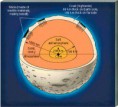Interior
Just like earth the moon, has three interior partitions -- crust, mantle, and core. Though, the composition, structure, and source of the zones on the moon are so much dissimilar from ones on Earth. What scientists know about the interior of moon and the earth has been determined by examining of seismic events -- earthquakes and moonquakes. The equipments used to study this event where arranged by Apollo astronauts from 1969 to 1972.
Crust
The standard deepness of the lunar crust is about 43 miles (70 kilometers), considered with about 6 miles (10 kilometers) for Earth's crust. The outmost portion of the moon's crust is split up, cracked, and disordered as a outcome of the big impacts it has encountered. These damaged zones are able to hold material under a depth of about 6 miles. The lower portion of the crust is classified as an abrupt increase in rock thickness at a depth of about 37 miles to the near side and about 50 miles on the far side.
Mantle
The moon’s mantle contains heavy rocks which are rich in iron and magnesium. During the period of global melting the mantle toke form, less dense minerals raised to the outwards layers of the moon, mean while thick minerals settle deeper into it. Afterwards, the mantle partially melted because of the increase of heat in the deep interior. The cause of the heat was most likely the decomposed of uranium and other radioactive elements. Basaltic magmas developed during this melting. The magmas went out to the surface and burst out as the mare lavas and ashes. Though mare volcanism happened for more than 1 billion years -- from at least 4 billion years to lesser than 3 billion years ago -- more less than 1 percent of the volume of the mantle yet dissolved.
Core
Information put together by Lunar Prospector shows that the moon has a core and allowed scientists to approximate its size. The core has a radius of about 250 miles (400 kilometers), by comparing, to the radius of Earth's core which is about 2,200 miles (3,500 kilometers). The core of the lunar has about less than 1 percent of the mass of the moon. Scientists think that the core might contain iron, and it could also consist of big amounts of sulfur and different elements. Earth's core is typically of molten iron and nickel, which the quick rotation of earth’s molten core is the cause of earth magnetic field. A magnetic field is a force that a magnetic object produces in the area surrounding it. Supposed the core of a planet or a satellite tend to be molten, movement inside the core induced by the rotation of the planet or satellite creates the core magnetic. Rather small part of the molten core of the moon will not be able to produce a global magnetic field. Though, smaller areas on the lunar surface are magnetic. Scientists are uncertain how those sections obtained magnetism. Possibly the more amount of molten rock the moon has might be the reason why. There is a proof that the lunar internal once consist of gas, and for that those gases might yet be there. Basalt from the moon includes holes called vesicles that are produced through a volcanic eruption. As on, Earth gas that is dissolved in molten rock originates from a solution through an eruption, just like carbon dioxide is produce out a carbonated beverage while you shake up the drink bottle. The existence of vesicles in lunar basalt shows that the deep internal consist of gases, most likely carbon monoxide or gaseous sulfur. The presence of volcanic ash is more proof of interior gas; On Earth, volcanic eruptions are mainly displaced by gas.


